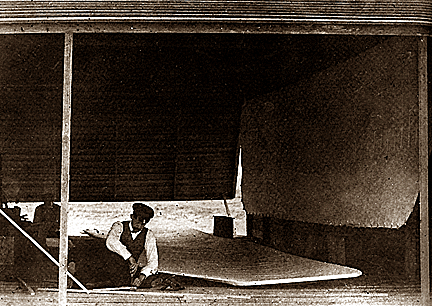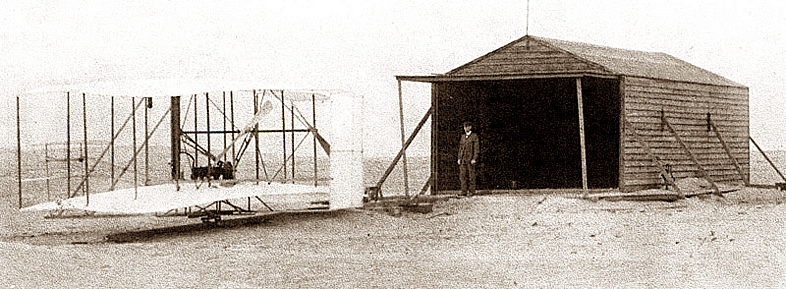|
 Because
of all the work they had to do on their machine, the brothers didn’t start
for North Carolina until October in 1903. Upon arrival at their camp on
October 8, a severe storm hit as they were unpacking the pieces of their new
machine. The Wrights spent a sleepless night in the rafters of their thin
shelter amid winds Wilbur estimated at 50 miles per hour. Because
of all the work they had to do on their machine, the brothers didn’t start
for North Carolina until October in 1903. Upon arrival at their camp on
October 8, a severe storm hit as they were unpacking the pieces of their new
machine. The Wrights spent a sleepless night in the rafters of their thin
shelter amid winds Wilbur estimated at 50 miles per hour.
The Wrights unpacked the last of its parts on the
worst day of the storm, then began assembling the three sections of the
upper wing and installing wires and hinges on October 12. By the time they
stretched the cloth two days later, they realized their new wings were to be
far ahead of anything they had built before.
Unlike their gliders, the 1903 Flyer was asymmetrical
since its lower wing had to accommodate both a pilot and a motor. The right
wings were four inches longer than the left, providing additional lift for
the motor, which was to be mounted slightly right of center. The pilot was
to lie to its left.
Next came the twin surfaces of the elevator, the tail
surfaces, the skids to be mounted beneath the craft, the braces, the wires
and pulleys between the upper and lower wings, the frame for the elevator
and the uprights between its upper and lower sections, and the frame for the
tail. By November 2, the Wrights prepared to assemble, mount, and test the
engine.

While
they needed little help in other years, that all changed in 1903. The 1901
glider had weighed under 100 pounds. The 1902 machine boasted 305 square
feet of wing area and a 32-foot wingspan. Two men could easily maneuver such
crafts. The 1903 Flyer had over 500 square feet of wing area, a 40-foot
wingspan, and weighed nearly 675 pounds. Now, the Wrights needed all the
help they could get. The men of the Kill Devil Hills Lifesaving Station came
to their rescue.
When Orville and Wilbur started up the engine on
November 5, it kept missing, backfiring, jerking spasmodically a if it were
about to quit. And it soon did. Both propellers broke loose, damaging their
shafts. With no equipment on hand to repair the damage, they had no choice
but to ship the shafts to Taylor in Dayton and wait for their return. Cold
descended on the sands of Kill Devil Hills.
On the day the propeller shafts arrived, the Wrights
installed them and tried the motor. The engine vibrated so badly that the
sprockets on the propeller shafts kept loosening up, a problem the Wrights
solved by applying a liberal dose of tire cement. Finally, the engine ran
reasonably well, and the propellers produced an adequate thrust to get their
craft into the air.
November 25 was to be the day of the first powered
flight, but rain, followed by more cold, set in just as they were ready to
take the machine out for a trial.

Disaster
struck again on November 28. With the engine running well, nothing stood in
their way. Or so it seemed. Upon close examination of the propeller shafts,
the brothers found a hairline crack. They realized that if they had
attempted to take to the air, a shaft might have disintegrated, becoming a
series of projectiles that would probably have ripped the aircraft apart.
Orville returned home to help Taylor make shafts of heavier steel. Wilbur
bided his time chopping wood and writing letters.
Orville returned December 11. The next day, they
installed the new propeller shafts and made preparations for a trial, only
to find there was inadequate wind for starting from level ground and not
enough daylight to wrestle the Flyer onto the dunes.
Sunday, December 13 offered favorable winds, but the
brothers had promised their father they’d observe the Sabbath no matter what.
Next: Success at Last
|
